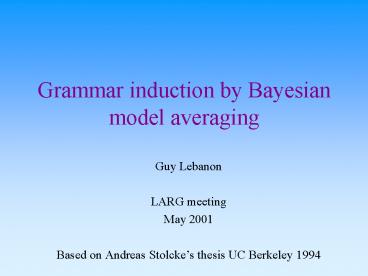Grammar induction by Bayesian model averaging - PowerPoint PPT Presentation
Title:
Grammar induction by Bayesian model averaging
Description:
Grammar induction by Bayesian model averaging Guy Lebanon LARG meeting May 2001 Based on Andreas Stolcke s thesis UC Berkeley 1994 Why automatic grammar induction ... – PowerPoint PPT presentation
Number of Views:154
Avg rating:3.0/5.0
Title: Grammar induction by Bayesian model averaging
1
Grammar induction by Bayesian model averaging
- Guy Lebanon
- LARG meeting
- May 2001
- Based on Andreas Stolckes thesis UC Berkeley 1994
2
Why automatic grammar induction (AGI)
- Enables using domain-dependent grammars without
expert intervention. - Enables using person-dependent grammars without
expert intervention. - Can be used on different languages (without a
linguist familiar with the particular language). - A process of grammar induction with expert
guidance may be more accurate than human written
grammar since computers are more adept than
humans in analyzing large corpora.
3
Why statistical approaches to AGI
- In practice languages are not logical structures.
- Often said sentences are not precisely
grammatical. The solution of expanding the
grammar leads to explosion of grammar rules. - A large grammar will lead to many parses of the
same sentences. Clearly, some parses are more
accurate than others. Statistical approaches
enable including a large set of grammar rules
together with assigning probability to each
parse. - There are known optimality conditions and
optimization procedure in statistics.
4
Some Bayesian statistics
- For each grammar (rule
probabilities rules), a prior probability p(M)
is assigned. This value may represent experts
opinion about how likely is this grammar. - Upon introduction of a training set X (an
unlabeled corpus), the model posterior is
computed by Bayes law - Either the grammar that maximizes the posterior
is kept (as the best grammar), or the set of all
grammars and their posteriors is kept (better).
5
Priors for CF grammars
- The prior of a grammar p(M) is split to two
parts - The component is taken to introduce a
bias towards short grammars (less rules). One way
of doing that, though still heuristic, is minimum
description length (MDL) - Prior for the rule probabilities is taken to be
uniform Dirichlet prior which has the effect of
smoothing low counts of rules usage.
6
Grammar posterior
- Too hard to maximize over the posterior of both
the rules and the probabilities. Instead, the
search is done to maximize the posterior of the
rules only - Where V is the Viterbi derivation of x. The last
integral has a closed form solution.
7
Maximizing the posterior
- Even though computing an approximation to the
posterior is possible in closed form, coming up
with a grammar that maximizes it is still a hard
problem. - A. Stolcke Start with many rules. Apply greedy
operations of merging rules to maximize the
posterior. - Model merging was applied to Hidden Markov
models, probabilistic context free grammar and
probabilistic attribute grammar (PCFG with
semantic features tied to non-terminals).
8
A concrete example PCFG
- A specific PCFG consists of a list of rules s and
a set of production probabilities . - For a given s, it is possible to learn the
production probabilities with EM. Coming up with
an optimal s is still an open problem. Stolckes
model merging is an attempt to tackle this
problem. - Given a corpus (set of sentences), an initial set
of rules is constructed
9
Merging operators
- Non-terminal merging replace two existing
non-terminals with a single new non-terminal. - Non-terminal chunking Given an ordered sequence
of non-terminals, create a new
non-terminal Y that expands to
and replaces occurrences of in right
hand side with Y.
10
PCFG priors
Prior for rule probabilities
Prior for rules For a non-lexical rule (doesnt
produce a terminal symbol) the description length
is
For a lexical rule (produces a terminal symbol)
the description length is The prior was taken to
be either exponentially decreasing or Poisson in
the description length
11
(No Transcript)
12
Search strategy
- Start with the initial rules.
- Try applying all possible merge operations. For
each resulting grammar compute the posterior and
choose the merge which resulted in the highest
posterior. - Search strategy
- Best first search,
- Best first with look-ahead
- Beam search
13
Now some examples































